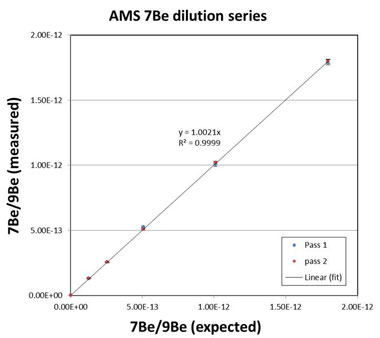Alan Hidy (16-FS-008)
Project Description
Cross-border tunnels represent a significant national security threat because they provide conduits for the transport of weapons, narcotics, and potential terrorists into the United States. The U.S. Customs and Border Protection agency has expressed interest in a capability for determining the age of these tunnels to infer their operational timescales. Unfortunately, because of the short timescale of interest—months to years—and the nature of dateable material available in these tunnels, there are currently no developed chronological tools available that can address this problem. We plan to assess the feasibility of using short-lived, cosmogenic, naturally produced radionuclides to determine the age of underground cross-border tunnels. Prior to use in a tunnel, construction materials accumulate these radionuclides either from direct exposure to cosmic radiation at the Earth’s surface or by incorporation of atmospherically produced radionuclides within the material during fabrication. Once inside the tunnel and covered by more than two meters of earth and rock, the materials are effectively shielded from the hadronic component (e.g., protons and neutrons) of cosmic flux, decreasing the significant component of the radionuclides, whose concentrations decrease predictably over time as a result of radioactive decay. This process provides a means to calculate how long materials have been underground. We are focusing on identifying cosmogenic radionuclides that are incorporated in materials commonly used in the construction of cross-border tunnels, such as concrete and steel rails, and have short half-lives such that they can resolve ages on the order of months to years. We will also identify the radionuclides that are present at concentrations that can be readily measured above background by decay counting or accelerator mass spectrometry. This assessment will serve as the first step toward a viable forensic technique for dating cross-border tunnels that is also broadly applicable to dating other man-made structures.
Because of the significant national security threat represented by cross-border tunnels, it is essential that U.S. protective agencies have forensics to analyze and defeat the threat these tunnels pose. With this feasibility study, we expect to identify potential paired isotopes worthy of further investigation, including their theoretical temporal resolution and applicability to common cross-border tunnel materials. In addition, we will develop a pilot data set demonstrating the feasibility of beryllium isotope burial dating in concrete (see figure). A successful feasibility study will help to demonstrate the forensic usefulness of this technique and aid in better evaluation of the threat posed by illicit cross-border tunnels. If this approach is shown to be successful, it will be of interest to the U.S. Customs and Border Protection agency and offer varied potential Department of Defense applications.
Mission Relevance
Our research furthers Lawrence Livermore’s core competency in nuclear, chemical, and isotopic science and technology by potentially expanding the application of a new and promising isotopic age-dating technique into the security arena with an assessment of the feasibility of using cosmogenic radionuclides to estimate the age of cross-border tunnels.
FY16 Accomplishments and Results
In FY16 we (1) conducted an assessment to identify promising isotopes, (2) began the first test sample measurement (of exposed copper wire) at a counting facility, (3) ordered laboratory materials required for beryllium isotope measurements in concrete, and (4) consulted with the U.S. Customs and Border Protection Agency on the viability of our technique.
One of our goals was to establish a measurement capability for ultra-trace levels of beryllium-7 at Livermore's Center for Mass Spectrometry, and results from the first accelerator mass spectrometry test run of this new capability are shown here. Measurements of a dilution series of beryllium-7 (7Be) material spiked with beryllium-9 (9Be) carrier agree well with expected values over a range of low-level ratios. This result suggests a detection capability of about 1,000 atoms of beryllium-7.






